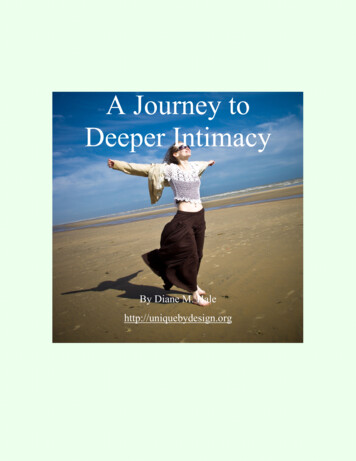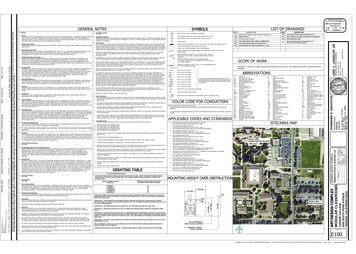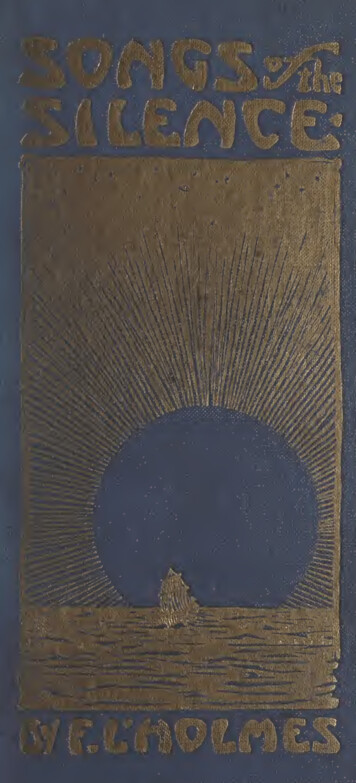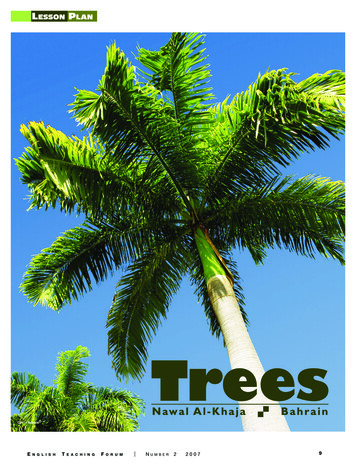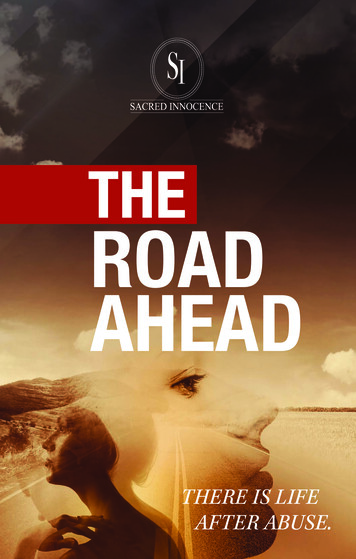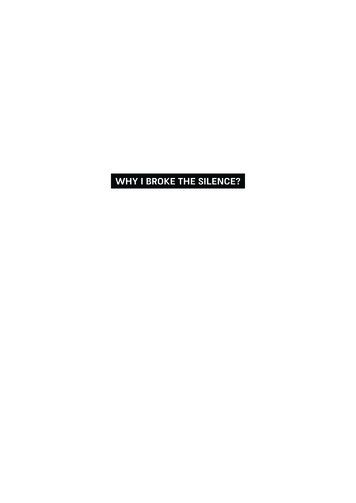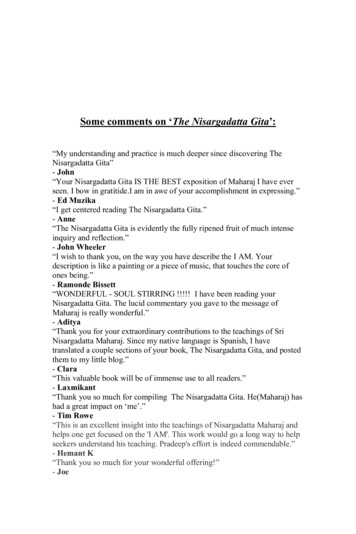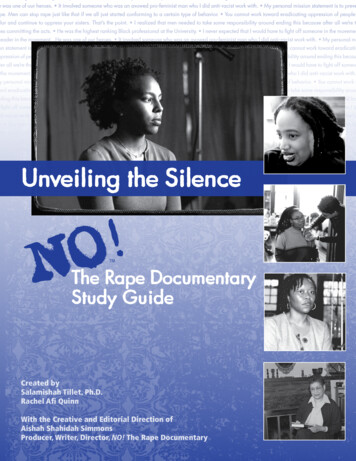
Transcription
Unveiling the SilenceTMThe Rape DocumentaryStudy GuideCreated bySalamishah Tillet, Ph.D.Rachel Afi QuinnWith the Creative and Editorial Direction ofAishah Shahidah SimmonsProducer, Writer, Director, NO! The Rape Documentary
Unveiling the Silence: The NO! Rape Documentary Study Guidewas funded by The Ford Foundation 2007 by AfroLez Productions, LLCISBN #: 978-0-615-16123-5Graphic Design: Kavita RajannaNO! Logo Design: Traci McKindraAfroLez Productions, LLCPO Box 58085Philadelphia, PA .orgCover Photos: (top center) Salamishah Tillet, photo by Scheherazade Tillet; (left, from top to bottom) Aishah Shahidah Simmons, photo by Scheherazade Tillet; Aaronnette M. White andGail Lloyd, photo by Scheherazade Tillet; Farah Jasmine Griffin, photo by Scheherazade Tillet; Charlotte Pierce-Baker, photo by Wadia Gardner.
Unveiling the Silence: NO! The Rape Documentary Study Guide is dedicated to:Every woman and girl victim/survivor who privately or publicly said “No” to rape and/or any other form of sexual assault.Every woman and girl victim/survivor who did not know that they had the right to privately or publicly say “No” to rape and/orany other form of sexual assault.It is also dedicated to:Leah MakedaIyana Marie AliNathalia SmithPilar JeffersonYasmeen BrownleeJerlast FosterAaliyah HunterNiyala BrownleeMico FazakasSajo JeffersonNiya RobertsCourtney SimmonsGinevra Aghatise GianassoImani CantonSrija Chatterjea SenMaya RamirezStella Roline PerraultSavannah McNealZaylese OrlenaZoe Bambara DanielZari Ciyani Thwaites-SimmonsMaazi Davis-CherryAmya BoltonSimone Renee XavierZenzele Etwaroo DanielsHaviland Sharpley-WhitingSojourner OrlenaAriana Ali-HarrisNoémi Chyenne RegoorMontsho CantonRieghne Madison DysonAmaya Soledad McDuffieMaia Angeline PerraultRachel OlomofeAmari Rose MealyAndie McClennon DotsonIfe Bryant-DavisSoleil XavierSky Sierra Lyric RayeDesta Davis-CherryElla Carmen Cohen-RitchieAvye Dai Thwaites-SimmonsSophia Bartoli-WrightJasmine ManéRyan Olivia DotsonAnd all girls born and yet to be born may they never experience the horror of incest, rape, or ANY other form of sexual violence ontheir journeys called life.
Purpose of GuideA tool for educators and workshop facilitators – This study guide may be used within a workshop, classsession, or semester-long course. You may decide to screen the documentary film in its entirety or use segmentsintegrated into a broader course addressing race, gender, and sexuality. Viewing the film in segments allows forit as a jumping off point for student-led exercises or longer activities.individuals who are taking action in their communities to educate themselves and each other about rape andsexual assault. The film will get conversations going in your communities and on your campuses. You might hosta screening of the film as a one-time event in your dorm, classroom, church, mosque, rape crisis center, shelter,correctional facility, living room, or in a community space, and facilitate a group discussion immediately followingthe screening or in the days following. Excerpts from the transcribed testimonies of rape survivors and quotes from the film to spark discussion Myths and facts about rape and sexual assault so participants in discussions have the relevant informationregarding the truth about sexual violence and its impact A glossary of terms useful for talking about sexual assault in the African-American community Discussion questions about the subject of sexual assault to promote positive and informative conversations for participantscontact@notherapedocumentary.org Summaries of the different chapters of the film This guide includes:www.NOtheRapeDocumentary.orgA tool for everyone – Our hope is that this study guide will be used as a companion to the film NO! by allThe Rape Documentary Study Guidediscussion related to themed sections. You may choose to work through the study guide chapter by chapter, or use Worksheets and handouts for participants to reflect on what they think they know about rape and sexualviolence in their communities4
Table of ContentsProducer/Director’s StatementAishah Shahidah Simmons contact@notherapedocumentary.orgThe Rape Documentary Study Guidewww.NOtheRapeDocumentary.org5page 7Synopsis of NO!page 11Creating a Safe Space for Discussionpage 13Glossary of Termspage 13Key Myths and Factspage 15Chapter Guides1. Introduction & Devastation of Date RapeSalamishah Tillet’s Testimony Acquaintance Rape and Consentpage 172. Weapon of History Slavery Lynching Great Migrationpage 20page 21page 22page 233. Survivors SilencedRev. Reanae McNeal’s Testimony Campus Safety Racial Solidaritypage 254. Civil Rights and WrongsGwendolyn Zoharah Simmons’s Testimony Sexual Harassment & Assault in the Civil Rights & Black Power Movements Black Power and Sexual Assault Black Lesbians and Activism Against Sexual Assault Black Women Writers and Sexual Assaultpage 18page 26page 27page 28page 29page 30page 31page 325. Raping the Next GenerationAaronette M. White’s Testimony Date Rape and Prevention Adolescent Sexual Abuse and Prevention Incestpage 336. Holding Men Accountable — Campus, Clergy, and Community Intraracial Betrayal and Sexual Violence Black Feminist Men and the Anti-Rape Violence Movement Black Leaders and Sexual Violence The Mike Tyson Trial Sexual Assault and Religion Media, Stereotypes, and a Rape Culturepage 38page 39page 40page 41page 42page 43page 44page 34page 35page 36
7. Unequal Justice Under LawAudree Iron’s Testimony Sexual Assault and the Criminal Justice System Disparities in the American Judicial Systempage 458. Healing, Faith, and HopeLoretta Ross’s Testimony Activism and Recovery Arts as Recovery Accountability and Recoverypage 48Epiloguepage 53The Role of Religion in Violence Against WomenGwendolyn Zoharah Simmons, Ph.D.page 54Meditations of Resistance: A Triptych of Total RegenerationTamara L. Xavier, M.Ed.page 58Appendixpage 60Because we .:A Statement on NO! by the UBUNTU Education Working Grouppage 61Taking Actionpage 62Media and Sexual Violencepage 63Group Activitiespage 64National Rape and Sexual Assault Resourcespage 66Rape and Sexual Assault Organizations by Statepage 67Recommended Readingpage 69Learn More about the Individuals in the Filmpage 72Film Creditspage 75Biographies of Contributors to the Study Guidepage 76Acknowledgementspage 78Notespage 83page 46page 47www.NOtheRapeDocumentary.orgThe Rape Documentary Study Guidepage 49page 50page 51 contact@notherapedocumentary.org6
Producer/Director’s StatementAishah Shahidah Simmons".and when we speak WEARE AFRAID our words willnot be heard nor welcomedwww.NOtheRapeDocumentary.org contact@notherapedocumentary.orgThe Rape Documentary Study Guidebut when we are silent,WE ARE STILL AFRAIDSo it is BETTER TO SPEAKrememberingWE were never meant tosurvive."–Audre Lorde1I am an African-American2 feminist lesbiancultural worker who for fifteen years primarily used the camera lens, as a producer,writer, and director, to make central someof the many things that have been andare on the periphery–the lives of AfricanAishah Shahidah Simmons; photo by Barbara KigoziAmerican lesbian and heterosexual women.I believe that using the camera lens to bring progressive ideas, images, perspectives, and voices from the margins to the centeris a form of social change. In 1992, I chose film/video as my tool to make progressive social change irresistible because welive in an age where people are inundated with images–the majority of which are both directly and indirectly manufacturedby a handful of global corporations. Very unfortunately, the overwhelming majority of these images either completely ignorethe majority of the world’s human inhabitants or they reinforce negative stereotypes of the majority of the world’s humaninhabitants.Since the early nineties, and largely as a result of the late Black feminist author and screenwriter Toni Cade Bambara’s3guidance and tutelage, I have had a deep and profound appreciation for and understanding of the critical need to shed lighton controversial and ignored subjects within African-American communities, without reinforcing stereotypes. My goal withmy work is to visually engage audiences while educating them and encouraging them to work toward eradicating all formsof oppression, which include but are not limited to: racism, sexism, homophobia, xenophobia, colonialism, and imperialism,in all of their violent manifestations.71 Audre Lorde was an award-winning and prolific, self-defined Black lesbian feminist mother warrior poet. Among her numerous awards,she was named the New York State Poet from 1991-1993. She published ten volumes of poetry and five volumes of prose before her untimely death in 1992.2 For the purpose of this study guide, the words Black and African-American are used interchangeably to describe the descendants ofenslaved Africans who were brought over, against their will and in chains, to the Americas, and landed on the mass of land now known asthe United States of America.3 Toni Cade Bambara was an award-winning Black feminist writer, filmmaker and cultural worker. During her lifetime, she edited twoanthologies, two short story collections, and a novel. As a screenwriter she worked on several award-winning documentaries. After heruntimely death in 1995, Toni Morrison published two pieces of Bambara’s writings, which were a collection of fiction, essays, and conversations; and a novel.
I am a Black woman who is a survivor of incest and rape.I was the young Black woman who in 1989, at 19 years old, six weeks shy of my 20th birthday, broke the rulesof the university where I attended by agreeing to sneak out after hours to meet the man who would becomemy rapist I was the Black woman who after breaking the university enforced rules started to have secondthoughts but was afraid to articulate them and was afraid to turn around because my friends were covering forme I was the Black woman who paid for the hotel room where I was raped. I was the Black woman whosaid, “I don’t want to do this. Please stop.” I didn’t “violently” fight back. I didn’t scream or yell to the top ofmy lungs because I was afraid. I didn’t want to make a “scene.” I told myself it was my fault because I willinglyleft the dorm, ignored school policy, and even paid for the hotel room I am one of countless, nameless, andvoiceless women, who experientially learned that the (often unchallenged) punishment for women who use poorjudgment with men is rape and other forms of sexual violence.www.NOtheRapeDocumentary.org contact@notherapedocumentary.orgIt should be noted that while NO! is the first documentary if its kind, it is a part of a long tradition of protest by Black womeneducators, writers, activists, artists, poets, filmmakers, cultural workers, and organizations, including but not limited to: thenarratives of enslaved African women, Sojourner Truth, Harriet Tubman, Ida B. Wells-Barnett, Amy Jaques Garvey, Zora NealeHurston, Rhoda Bell Temple-Robinson-Hudson-Douglas, Beah Richards, Louise Patterson, Rebecca White-Simmons-Chapman,Jesse Neal Hudson, Mattie SimmonsBrown, Ella Baker, Toni Morrison, MayaAngelou, Fannie Lou Hamer, Nina Simone, Toni Cade Bambara, Ruby Dee,Gwendolyn Zoharah Simmons, ElaineBrown, Ruby Doris Smith Robinson,Diane Nash, Shirley Chisolm, FlorenceKennedy, Johnnetta Betsch Cole, theNational Black Feminist Organization,the Combahee River Collective, AliceWalker, Sonia Sanchez, Audre Lorde,Loretta J. Ross, Nkenge Toure, AngelaY. Davis, ntozake shange, Elsa Barkley Brown, Michelle Wallace, BarbaraSmith, Beverly Guy-Sheftall, SweetHoney In The Rock, Pearl Cleage, bellhooks, Julie Dash, Michelle Parkerson,Ayoka Chenzira, Zeinabu irene Davis,the National Black Women’s HealthProject, and African-American WomenIn Defense of Ourselves. Their scholarship, activism, films, and culturalwork broke the ground and paved theBarbara Smith and Aishah; photo by Joan Brannonway for NO! to exist today.The Rape Documentary Study GuideRape and other forms of sexual violence are some of the most underreported crimes in the United States because most victimsbelieve that the atrocities committed against them are private or personal matters. I know too many Diasporic African womenwho are incest and rape survivors. And yet, in spite of this reality, there is an “uncanny silence surrounding the trauma of Blackrape.”4 In 1994, this deafening silence led me on an eleven-year international grassroots journey to produce, write, and directNO! The Rape Documentary, a feature length documentary which unveils the realities of rape, other forms of sexual violence,and healing in African-American communities.In NO! Black women's voices and experiences are integral–not on the sidelines, not on the periphery but in the center ofthe work–without any excuses or apologies. I believe this directorial decision is a revolutionary act because to paraphraseToni Cade Bambara, none of us are aurally or visually-trained to prioritize, much less make central, Black women’s lives. That4 Charlotte Pierce-Baker, Surviving the Silence: Black Women’s Stories of Rape (Norton, 2000).8
was the challenge that Julie Dash5faced with her cinematic masterpiece Daughters of the Dustbecause that breathtaking filmrequired viewers to visually experience Black women’s lives at theturn of the twentieth century. contact@notherapedocumentary.orgThe Rape Documentary Study Guidewww.NOtheRapeDocumentary.orgWithin an intraracial Black context,NO! addresses the classist notionthat rape, sexual assault, andother forms of gender-basedviolence are only perpetrated bythe hands of working class Blackmen who live in the “hood” orin the “ghetto.” The majority ofthe victim-survivor testimoniesfeatured in NO! challenge theclassist stereotype that Blackmen with academic degrees,Charlotte Pierce-Baker, Joan Brannon, Gail Lloyd and Aishah; photo by Wadia L. Gardinerhigh profiles, or who are on thefrontlines fighting for racial liberation are incapable of being sexist, misogynistic, and/or predatory.“He was the highest ranking Black professional at the University.”“I never expected that I would have to fight off someone in the movement, a leader in the movement. He wasone of our heroes.”“It involved someone who was an avowed pro-feminist man who I did anti-racist work with.”There are no White experts in NO! and that is very conscious decision. While I believe that White women and men have saidand continue to articulate some important things about rape and sexual assault in the Black community, my vision and mygoal for NO! is for Black women and men to address rape, other forms of sexual violence, and healing in our non-monolithiccommunity. I want all viewers to see Black women as victim-survivors of rape and other forms of sexual violence whilesimultaneously seeing them as activists, scholars, theologians, cultural workers, and agents for social change.Equally as important, I want viewers to see Black men as staunch advocates against rape and sexual violence. Many ofthe featured men in NO! have a demonstrated track record of being on the frontlines of the anti-violence against womenmovement.“My personal mission statement is to prevent rape. Men can stop rape just like that if we all just startedconforming to a certain type of behavior.”“You cannot work toward eradicating oppression of people of color and continue to oppress your sisters. That’sthe point.”“I realized that men needed to take some responsibility around ending this because after all we’re the onescommitting the acts.”95 Julie Dash is an award-winning, critically acclaimed African-American woman filmmaker who has been producing, writing, and directingfilms and videos since 1973. She was the first African-American woman to have a full length general theatrical release with the debut ofDaughters of the Dust in 1992. In December 2004, The Library of Congress placed Daughters of the Dust in the National Film Registry to join400 American films preserved as National Treasures.
Frequently during question and answer sessions following screenings of NO! I am asked if I am concerned that the film willperpetuate the racist stereotype of the Black male rapist. My first response is that the racist stereotype is that of Black menraping White women, not Black women. We usually don’t flip the metaphorical racial coin, as Salamishah Tillet does in heraward-winning essay “Fragmented Silhouettes.” The other side of that racist stereotype is the Black woman “whore” whois incapable of being raped because she’s always wanting, willing, and able to have sex. More often than not when we arethinking about victims-survivors of sexual assault we don’t think about, much less visualize women of color who have beensexually assaulted. As you will read in this study guide, the overwhelming majority of rapes are intraracial. However, whenit comes to interracial rape, according to FBI Statistics, White men rape Black women at a higher rate than Black men rapeWhite women. Whether it’s intraracial or interracial rape or other forms of sexual assault, Black women, when compared toWhite women, get less justice. contact@notherapedocumentary.orgFrom an 8 minute work-in-progress to a completed feature length documentary, NO! has been screened extensively toracially and ethnically diverse audiences internationally. These screenings and discussions have ranged from as small as twopeople to as large as 500 people. To date, there hasn’t been one screening, on either side of the Atlantic Ocean, when at leastone girl or woman, or sometimes a man, from across the racial, national origin, ethnicity, religion, language, culture, sexualorientation, and class spectrum, has not disclosed to me personally or the entire NO! viewing audience that NO! created thespace for them to share that they have been raped or experienced some form of sexual violence. Based on these experiences,I believe NO! has the power to challenge, if not transform, people’s thinking about heterosexual rape and sexual assault. Itis my affirmation that NO! will continue to be used as one of the many resources in the global movement to end all forms ofsexual violence.www.NOtheRapeDocumentary.orgJohnnetta Betsch Cole and Aishah; photo by Joan BrannonIt’s an experience such as this thatconstantly underscores the utmostimportance that when White women and men (and/or predominantlyWhite organizations and institutions) organize events and discussions about ending rape and sexualassault, the voices, experiences,perspectives, and cultural work ofDiasporic African, Latina, Indigenous/Native American, Asian, Arab,and Pacific Islander women, who arevictim-survivors and/or activists inthe violence against women movement, are consulted and included.The Rape Documentary Study GuideAfter a screening of NO! at apredominantly White university, ayoung White woman viewer saidto me, “Wow, thank you for yourdocumentary. Prior to seeing NO!I didn’t know that Black womencould get raped.”10
Synopsis of NO!NO! is the first documentary of its kind! contact@notherapedocumentary.orgThe Rape Documentary Study Guidewww.NOtheRapeDocumentary.orgProduced and directed over a period of elevenyears, seven of which were full-time by AishahShahidah Simmons, NO! unveils the realities ofrape, other forms of sexual violence, and healing in African-American communities, throughintimate testimonies from Black women victimsurvivors, commentaries from acclaimed African-American scholars and community leaders,impactful archival footage, spirited music, transformational dance, and performance poetry. NO!also examines how rape is used as a weapon ofhomophobia.For ninety-four minutes, NO! gives viewers theopportunity to experience the international reality of rape and other forms of sexual violencethrough the testimonies, scholarship, activism,spirituality, and cultural work of African-Americans.What does it look like to visually make centralthat which has been placed on the margins andon the periphery? Moving from the enslavementof African people in the United States throughthe present day, NO! travels from rage, trauma,and emotional and physical pain to meditation,action, and healing. It is a journey through theexperiences of the featured Black women survivors of rape and sexual assault, who range in age, geographic location, andsexual orientation, and transform themselves from victims to survivors to educators to activists to healers. NO! writes AfricanAmerican women back into African-American history, recognizing and responding to the rape and sexual assault of Blackwomen and girls.Based on an understanding that heterosexual violence against women will end when all men make ending this internationalatrocity a priority in their lives, the commentary and performance of five Black male activists and cultural workers are placedalongside the African-American women’s voices. While NO! explores how the collective silence about acts of sexual assaultadversely affects African-Americans, it also encourages dialogue to bring about healing and reconciliation between all menand women.Since its official release in 2006, NO! has been screened and used internationally as an educational organizing tool with raciallyand ethnically diverse audiences at community centers, colleges/universities, high schools, juvenile correctional facilities, rapecrisis centers, battered women’s shelters, conferences, and film festivals throughout the United States, and in Italy, Spain,Rwanda, South Africa, Hungary, Jordan, Peru, Nepal, Congo, Uzbekistan, Burkina Faso, Kenya, France, and Mexico.NO! received both a juried award and an audience choice award at the 2006 San Diego Women Film Festival. The NationalSexual Violence Resource Center–the comprehensive center for information, research, and emerging policy on sexual violenceintervention and prevention in the United States–designated screenings of NO! in community settings as the Featured Eventof its 2007 National Sexual Assault Awareness Month campaign.11
DVD Chapter Selections3) Survivors Silenced Survivor’s Story: Rev. Reanae McNeal —“Break-up” battery, Stand by your (Black) Man Silence will not save our communities00:15:38:1800:20:04:094) Civil Rights and Wrongs Sexual harassment & assault in Civil Rights & Black Power Movements Survivor’s Story: Gwendolyn Zoharah Simmons — Battle within SNCC Feminism and anti-racism Lesbian women in solidarity, “Gay-baiting” in the Movement Survivor’s Story: Queen — Rape threats as gay bashing Black women writers: center stage on 1600:38:24:1100:40:33:035) Raping the Next Generation Lifelong impact Survivor’s Story: Rosetta Williams — Uninformed consent Sex education helps prevent sexual violation Watchful eye on family ties00:43:12:1700:43:27:0900:47:33:2300:49:04:016) Holding Men Accountable — Campus, Clergy and Community Survivor’s Story: Janelle White — Men challenging men Men Stopping Violence Survivor’s Story: Aaronette M. White — Power without accountability Failures of leadership: Mike Tyson conviction Media, Music & 1601:06:23:167) Unequal Justice Under Law Unequal rates of conviction Survivor’s Story: Audree Irons — Hands of a stranger Inadequate justice for women of color survivors01:08:57:1701:09:28:0101:12:03:218) Healing, Faith, & Hope Reaching out for help, Sharing in confidence, Healing journeys Alternative justice and community accountability Outro, Dedication, therapedocumentary.org00:07:20:2000:11:26:20 2) Weapon of History: Slavery, Freedom, Sexploitation Slavery as a sexual economy Lynching & Migration: race, sex and 01:51:0100:02:32:0400:02:59:1100:06:05:28The Rape Documentary Study Guide1) Introduction & Devastation of Date Rape Introduction Desire of film: “A sense of community founded on justice, not silence.” Men stopping violence against women Survivor’s Story: Salamishah Tillet — Date rape, Silence is not consent Negotiating sexual consent12
Creating a SafeSpace DiscussionThe sobering occurrence of rape reminds us that in oursociety all of us are impacted by violence against women.It is unlikely that participants in a class, workshop, orviewing of the film NO! will not know someone who hasbeen affected by sexual violence.www.NOtheRapeDocumentary.org contact@notherapedocumentary.orgThe Rape Documentary Study GuideIn preparation for a screening of NO! and beforediscussions on the topic of sexual assault in the Blackcommunity, please remind participants of the following: It is possible that the content of the filmand comments by interviewees may triggeremotional feelings or memories of experiences of one’s own sexual trauma or that ofsomeone close to you. It is difficult to discuss the topic of rapeand sexual assault because it is deemedpersonal as well as shameful to do so in oursociety. Laughter among discussion participants, which is interpreted as disrespectfulwhen discussing such serious subjects, mayreflect discomfort with the topic. It is important that participants are committed to creating a safe space for open andhonest discussion with each other. To keepthe conversation open, participants willneed to commit to a level of confidentialityand should not repeat personal informationoutside of the discussion. In leading a group discussion, whether itis in a semester-long course, or an 8-hourworkshop, you will likely find that discussions about rape and sexual assault willbe more fruitful and open if you provideparticipants with the opportunity to get toknow each other over time before launching into discussion. Allow students time toget to know each other beforehand, over aseveral week period if possible. For workshops or one-time meetings,conducting an ice breaker activity will helpyou build trust with the group and leadthe participants to an honest and frankdiscussion.13GlossaryAccountability is a readiness to have one’s actionsjudged by others. When appropriate, it also means beingable to accept responsibility for unjust actions and misjudgments, and recognizing the need to change in the light ofimproved understanding gained from others.Acquaintance Rape is a sex crime committed bysomeone who knows the victim. It could be a friend, lover,classmate, relative, or co-worker. As a sex crime, acquaintance rape includes forced, manipulated, or coerced sexualcontact.Art Therapy is the therapeutic use of art-making, withina professional relationship, by people who experience illness, trauma, or challenges in living, and by people whoseek personal development.Black Feminism is a movement that argues that sexismand racism are inextricable from one another. Black Feminism has its origins in the late nineteenth-century, and hasthree underlying tenets: that Black men have often assertedtheir “rights to be men” by restricting these same rightsfor Black women; that Black male leaders often considerit inappropriate for Black women to play a leading role infighting for Black freedom and justice; and that the mainstream feminism in the United States, from the suffragiststo pro-choice advocates, define feminism by excluding theneeds and rights of women of color and poor women.Consent means explicit words or actions that show avoluntary agreement to engage in mutually agreed-uponsexual activity.Date Rape is a form of acquaintance rape, when someone is raped by someone they have dated or are dating.As a sex crime, date rape includes forced, manipulated, orcoerced sexual contact.Homophobia is the irrational fear of, aversion to, anddiscrimination against lesbians, gay men, and bisexual menand women.Incest is the sexual abuse of a child by a relative or otherperson in a position of trust and authority over the child.A child molested by a stranger can run home for help andcomfort; a victim of incest cannot. Incest has been cited asthe most common form of child abuse. Studies concludethat 43% of the children who are abused are abused byfamily members, 33% are abused by someone they know,
and the remaining 24% are sexually abused by strangers.Other research indicates that over 10 million Americanshave been victims of incest.Interracial Rape is a sexual assault in which the victim and the offender are from different racial and ethnicbackgrounds.Intraracial Rape is a sexual assault in which the victim and the offender are of the same race.blame, isolation, and shame, many victims seek psychological help in order to deal with the short term andlong term impact of their assault. As such, with professional help and an extensive network of supportivefriends and family members, many victims of sexual violence begin to see themselves as “survivors” and learnto integrate the trauma into their concept of self.Rape Trauma Syndrome/Post Traumatic StressDisorder (PTSD) is a psychiatric disorder that can oc-raped and oftentimes experiences the immediate symptoms of heightened anxiety, self-blame, denial, frequentflashbacks, nightmares, fear for physical safety, emotional turmoil, and in severe cases psychological breakdownsand attempted suicide.Perpetrator is a person who has committed a crimeSexual Economy as used by law professor AdrienneDavis, describes the relationship between sex, law, profit,and power during slavery. More specifically, sexual economy refers to the physical, legal, and economic controlthat slave masters had over enslaved Black women andthe financial capital they derived from their reproductiveand sexual relationships.against another person. We use the terms “perpetrator,”“offender,” and “assailant” interchangeably throughoutthis guide.Rape is a crime in which forced, manipulated, or coerced sexual intercourse takes place.Rape Culture describes a society in which se
Study Guide TM Unveiling the Silence Created by Salamishah Tillet, Ph.D. Rachel Afi uinn With the Creative and Editorial Direction of . I chose film/video as my tool to make progressive social change irresistible because we live in an age where people are inundated with images-the majority of which are both directly and indirectly manufactured

